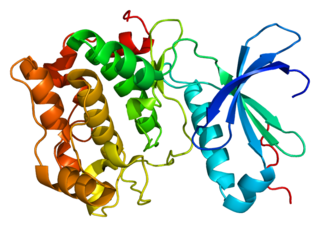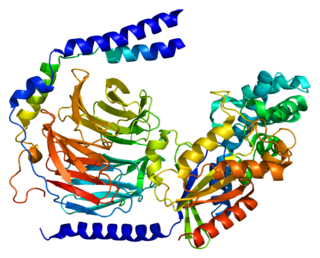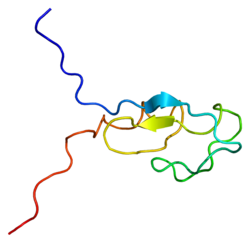
G-protein-coupled receptor kinase 2 (GRK2) is an enzyme that in humans is encoded by the ADRBK1 gene. GRK2 was initially called Beta-adrenergic receptor kinase, and is a member of the G protein-coupled receptor kinase subfamily of the Ser/Thr protein kinases that is most highly similar to GRK3(βARK2).

Protein kinase C alpha (PKCα) is an enzyme that in humans is encoded by the PRKCA gene.

Protein kinase C, zeta (PKCζ), also known as PRKCZ, is a protein in humans that is encoded by the PRKCZ gene. The PRKCZ gene encodes at least two alternative transcripts, the full-length PKCζ and an N-terminal truncated form PKMζ. PKMζ is thought to be responsible for maintaining long-term memories in the brain. The importance of PKCζ in the creation and maintenance of long-term potentiation was first described by Todd Sacktor and his colleagues at the SUNY Downstate Medical Center in 1993.

Protein kinase C delta type is an enzyme that in humans is encoded by the PRKCD gene.

Protein kinase C beta type is an enzyme that in humans is encoded by the PRKCB gene.

RAC-gamma serine/threonine-protein kinase is an enzyme that in humans is encoded by the AKT3 gene.

Protein kinase C theta (PKC-θ) is an enzyme that in humans is encoded by the PRKCQ gene. PKC-θ, a member of serine/threonine kinases, is mainly expressed in hematopoietic cells with high levels in platelets and T lymphocytes, where plays a role in signal transduction. Different subpopulations of T cells vary in their requirements of PKC-θ, therefore PKC-θ is considered as a potential target for inhibitors in the context of immunotherapy.

Retinoic acid-induced protein 3 is a protein that in humans is encoded by the GPRC5A gene. This gene and its encoded mRNA was first identified as a phorbol ester-induced gene, and named Phorbol Ester Induced Gen 1 (PEIG-1); two years later it was rediscovered as a retinoic acid-inducible gene, and named Retinoic Acid-Inducible Gene 1 (RAIG1). Its encoded protein was later named Retinoic acid-induced protein 3.

Protein kinase C iota type is an enzyme that in humans is encoded by the PRKCI gene.

Serine/threonine-protein kinase D1 is an enzyme that in humans is encoded by the PRKD1 gene.

1-Phosphatidylinositol-4,5-bisphosphate phosphodiesterase gamma-2 is an enzyme that in humans is encoded by the PLCG2 gene.

Protein kinase C eta type is an enzyme that in humans is encoded by the PRKCH gene.

Serine/threonine-protein kinase D3 (PKD3) or PKC-nu is an enzyme that in humans is encoded by the PRKD3 gene.

cAMP-dependent protein kinase catalytic subunit beta is an enzyme that in humans is encoded by the PRKACB gene.

Guanine nucleotide-binding protein G(I)/G(S)/G(O) subunit gamma-2 is a protein that in humans is encoded by the GNG2 gene.

Chimerin 2 (beta-chimaerin) is a protein that in humans is encoded by the CHN2 gene.

Serine/threonine-protein kinase D2 or PKD2 is an enzyme that in humans is encoded by the PRKD2 gene.

cAMP-dependent protein kinase catalytic subunit gamma is an enzyme that in humans is encoded by the PRKACG gene.

Leukocyte receptor tyrosine kinase is an enzyme that in humans is encoded by the LTK gene.

Mitogen-activated protein kinase 10 also known as c-Jun N-terminal kinase 3 (JNK3) is an enzyme that in humans is encoded by the MAPK10 gene.



























